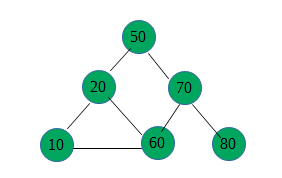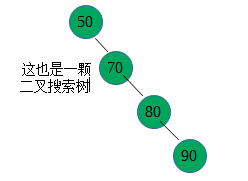树
结合了有序数组和链表的优点。在树中查询和在有序数组中一样快;插入和删除和链表一样快。
遍历相对比较慢一点。
从根到其它任何一个节点有且只有一条路径,比如下面的图示不是树:

多路树
每个节点的子节点可以多于两个
二叉树
每个节点的子节点最多有两个
二叉搜索树
一个节点的左子节点的数小于该节点,右子节点的数大于或等于该父节点

其它二叉树
二叉树并不全是搜索树。二叉树可以用于表示代数表达式,还可以用于哈夫曼编码以令人惊讶的方式压缩数据。
二叉搜索树的代码

class Node { public int iData; public double dData; public Node leftChild; public Node rightChild; public void displayNode() { System.out.print('{'); System.out.print(iData); System.out.print(", "); System.out.print(dData); System.out.print("} "); } } class Tree { private Node root; public Tree() { root = null; } /* 前序遍历 * 二叉树(不是二叉搜索树)可以表示包括二元操作符的算术表达式。 * * * a + * b c * 中序遍历会得到中序表达式,不过要自己加括号 * 前序遍历会得到前序表达式 * 后序遍历会得到后序表达式 */ private void preOrder(Node localRoot) { if (localRoot != null) { System.out.print(localRoot.iData + " "); preOrder(localRoot.leftChild); preOrder(localRoot.rightChild); } } // 中序遍历,最常用,如果是二叉搜索树结果升序。 private void inOrder(Node localRoot) { if (localRoot != null) { inOrder(localRoot.leftChild); System.out.print(localRoot.iData + " "); inOrder(localRoot.rightChild); } } // 后序遍历 private void postOrder(Node localRoot) { if (localRoot != null) { postOrder(localRoot.leftChild); postOrder(localRoot.rightChild); System.out.print(localRoot.iData + " "); } } // 插入 public void insert(int id, double dd) { Node newNode = new Node(); newNode.iData = id; newNode.dData = dd; if (root == null) root = newNode; else { Node current = root; Node parent; while (true) { parent = current; if (id < current.iData) { current = current.leftChild; if (current == null) { parent.leftChild = newNode; return; } } else { current = current.rightChild; if (current == null) { parent.rightChild = newNode; return; } } } } } // 查找 public Node find(int key) { Node current = root; while (current.iData != key) { if (key < current.iData) current = current.leftChild; else current = current.rightChild; if (current == null) return null; } return current; } // 删除 public boolean delete(int key) { Node current = root; Node parent = root; boolean isLeftChild = true; while (current.iData != key) { parent = current; if (key < current.iData) { isLeftChild = true; current = current.leftChild; } else { isLeftChild = false; current = current.rightChild; } if (current == null) return false; } if (current.leftChild == null && current.rightChild == null) { if (current == root) root = null; else if (isLeftChild) parent.leftChild = null; else parent.rightChild = null; } else if (current.rightChild == null) if (current == root) root = current.leftChild; else if (isLeftChild) parent.leftChild = current.leftChild; else parent.rightChild = current.leftChild; else if (current.leftChild == null) if (current == root) root = current.rightChild; else if (isLeftChild) parent.leftChild = current.rightChild; else parent.rightChild = current.rightChild; else { Node successor = getSuccessor(current); if (current == root) root = successor; else if (isLeftChild) parent.leftChild = successor; else parent.rightChild = successor; successor.leftChild = current.leftChild; } return true; } private Node getSuccessor(Node delNode) { Node successorParent = delNode; Node successor = delNode; Node current = delNode.rightChild; while (current != null) { successorParent = successor; successor = current; current = current.leftChild; } if (successor != delNode.rightChild) { successorParent.leftChild = successor.rightChild; successor.rightChild = delNode.rightChild; } return successor; } public void traverse(int traverseType) { switch (traverseType) { case 1: System.out.print(" Preorder traversal: "); preOrder(root); break; case 2: System.out.print(" Inorder traversal: "); inOrder(root); break; case 3: System.out.print(" Postorder traversal: "); postOrder(root); break; } System.out.println(); } public void displayTree() { Stack globalStack = new Stack(); globalStack.push(root); int nBlanks = 32; boolean isRowEmpty = false; System.out.println( "......................................................"); while (isRowEmpty == false) { Stack localStack = new Stack(); isRowEmpty = true; for (int j = 0; j < nBlanks; j++) System.out.print(' '); while (globalStack.isEmpty() == false) { Node temp = (Node) globalStack.pop(); if (temp != null) { System.out.print(temp.iData); localStack.push(temp.leftChild); localStack.push(temp.rightChild); if (temp.leftChild != null || temp.rightChild != null) isRowEmpty = false; } else { System.out.print("--"); localStack.push(null); localStack.push(null); } for (int j = 0; j < nBlanks * 2 - 2; j++) System.out.print(' '); } // end while globalStack not empty System.out.println(); nBlanks /= 2; while (localStack.isEmpty() == false) globalStack.push(localStack.pop()); } // end while isRowEmpty is false System.out.println( "......................................................"); } }
树的效率
| 节点数 | 层数 |
| 1 | 1 |
| 3 | 2 |
| 7 | 3 |
| 15 | 4 |
| 31 | 5 |
| ... | ... |
| 1023 | 10 |
| ... | ... |
| 32767 | 15 |
| ... | ... |
| 1048575 | 20 |
| ... | ... |
| 33554432 | 25 |
| ... | ... |
| 1073741824 | 30 |
如果一颗树是绝对平衡的满树,该树有L层,那么最差的查询效率是L次。
设表中节点数是N,层数是L,则N = 2L - 1;L = log2(N+1),大致为L=Log2N 。因此,常见的树的操作时间复杂度大致是O(LogN)。
如果树不满,分析起来比较困难。不过,在这种情况下,在较低层查找的次数要少。
